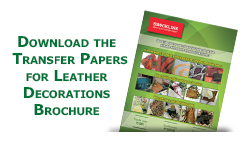How are they printed?
With wide format digital printers and solvent, ecosolvent, latex based inks...
What are the characteristics and differences?
The PS SOFT, PS SOFTKR and SOFTKR2 transfer papers provide a soft touch and do not change the leather's natural look. They are particularly suitable for full-grain leather and ideal for half-grain. They have excellent printability and ensure high productivity and quality.
The neutral skins ready for printing can be in the "Crast" state or either optimized for transfer papers (with tannery primers). Pre-conditioned leathers with wax or oil and water repellent agents are not suitable.
They feature a high quality transferable "coating" that is incorporated into the final finishing tannery process without leaving any trace. The thickness of the transferable coating ranges from 2.5 grams for the PS SOFTKR to 6.5 grams for the PS SOFT, according to the chosen option.
Which are the printing settings?
The printing settings are:
• High quality
• Low ink limit profile
• Heaters: 40°C to 50°C
• Print speed may vary depending on the equipment
Before printing, accurately choose a suitable profile especially when using PS SOFTKR (thinner coating), to get very intense colors.
It is not recommended to use white or metallic inks, which are difficult to transfer. However in this case a primer is necessary. Never wrap up the printed product until the solvent or latex totally evaporate as this would damage the prints and the consequent transfer.
How are they transferred on leather?
The application is obtained by a heat transfer process with calendars or flat heat presses.
Which are the transfer instructions?
With protection (soft silicon mat)
approx. 145°C for 60-70"
Without protection
120°C - 130°C for 10-20"
The minimum pressure for a good application is approx. 600 gr/sqm. Higher pressure means minor pressing time.
Flat-bed tannery heat presses work at 110°C at 5-10", "Rotopress type" calendars at 120°C -140°C with 4m/min speed. "Rotopresses" and Flat-bed tannery heat presses give best results.
Support paper must be removed when cool.
What to do to ensure wear resistance?
Two tanning processes are necessary:
› the first based on penetrants (solvent / ethyl acetate) usually used in tanneries to allow a deep penetration of the pigments in the skin.
› the second, based on acrylic resins, polyurethanes and waxes provides improved mechanical resistance and gives a very soft and velvety feel to the skin.
All these products (for pre and post conditioning) are normally used in tanneries.
The result is a deep, very stable and resistant decoration. |

